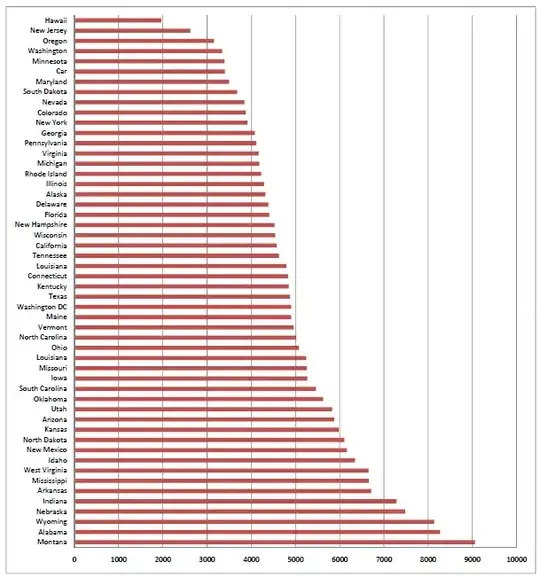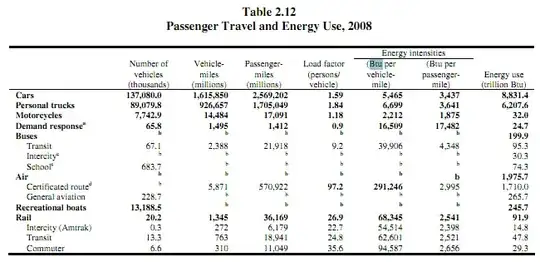Yes, public buses appear to be worse than cars, at least based on the data I found for the US.
(At present and on average. See the "Caveats" section for a discussion about this.)
Edit: the answer from DJClayworth appears to be based on the same information, I just noticed. bbc.co.uk just links to the overview for the Dept. of Energy report, but doesn't break things down.
Update: I used data from National Transit Database (LINK) to calculate BTUs/passenger-mile for every US city. I was initially unsure of how to do this, but I just wasn't looking at the right documents. The data I used is available in the bundle of Excel files titled, "RY 2009 Data Tables - Complete Set (Self-extracting xls)" (LINK). The necessary files are "T17_Energy_Consumption.xls" and "T19_Op_Stats_Service.xls." From these, I was able to compare fuel used to passenger-miles traveled for all buses in the country. The results are as follows:

The Excel files above list all public transportation by type, so I sorted and pulled out all bus listings, then summed the listed passenger-miles for each state. I also used the conversion factors mentioned below to convert all of the fuel listing into BTUs and then simply divided BTUs by passenger-mile to find the rates. I used the value of 3,400 BTUs/passenger-mile as listed below and inserted "Car" into the chart. It appears 6th in the list; in other words, only five US states have achieved an efficiency higher than a car for transporting individuals.
See below for discussion about BTUs
I left the rest of the answer mostly as it was -- it jives fairly well with this data, other than the bus average coming out to about 5,000 BTUs/passenger-mile with the National Transport Database data vs. the Department of Energy value below of 4,300.
Data/Analysis
Data to attempt to answer this question may reside in The Transportation Data Energy Book, published by the US Department of Energy (DoE). We will be pulling from Edition 29, published in June 2010 (available HERE).
Table 2.12 is shown here (LINK):

To highlight the pertinent values for 2008:
- Cars: 137 million cars traveled 1.6 quadrillion miles for a total of 2.6 quadrillion passenger-miles, and consumed 8.8 quadrillion BTUs of energy to do so.
- Buses: 67,000 buses traveled 2.4 billion miles for a total of 21.9 trillion passenger-miles and consumed 95 trillion BTUs of energy to do so.
Passenger-miles are a summation of (passengern * milesn) for all passengers (1 passenger mile = 1 passenger travelling 1 mile, 2 passengers travelling 0.5 miles, etc.).
The key value is BTU/passenger-mile:
- Cars: 3,437 BTUs/passenger-mile
- Buses: 4,348 BTUs/passenger-mile
This means that, on average, it is taking buses more energy than it takes cars to transport a given number of individuals a given amount of distance.
By using BTUs, fuel types are normalized by converting to energy per volume. See Table 2.5 in Chapter 2 (LINK) for a breakdown of fuel type usage by vehicle type. Also, Appendix A (LINK) provides the conversion factors for different fuels to BTUs.
BTU Discussion
The British Thermal Unit is a unit of energy. Analogs would be the calorie and the joule. Thus, the Department of Energy has taken each fuel type and translated it to an energy per volume output. Thus, if we know that a gallon of fuel X outputs Y BTUs, and we know the average number of BTUs required to move vehicle type Z a given distance, we have an efficiency value for each type of vehicle that has been normalized from fuel type to energy. Then we can analyze the energy required to transport a vehicle with it's typical passenger load (9.2 passengers per vehicle for buses, and 1.57 passengers per vehicle for cars) and determine energy per "passenger-mile."
We want a lower value here, since lower BTUs/passenger-mile means that it takes less energy to transport a given number of passengers a given distance.
See Table 11.11 in Chapter 11 (LINK) for a breakdown of emissions by fuel type. Buses primarily use diesel, while cars primarily use gasoline; the emissions for these two aren't all that different, with diesel at 10,000 grams/gallon emitted and gasoline at 8,800 grams/gallon.
Caveats
First off, this is only US data. I have no idea how the rest of the world compares.
Second, this is a snapshot. If buses were to increase their average "load factor" (persons/vehicle) such that their passenger miles were 30,000, they would be more efficient than cars on average. If buses reduced their BTU consumption, this would also help a great deal (I was blown away by the fact that buses require almost 8x the BTUs to travel 1 vehicle-mile compared to cars and 7x for trucks). Now, this is the data for all buses in all cities in operation. Thus, there are probably some cities doing quite well, while others are doing horribly. This paper abstract seems to confirm the same (emphasis mine):
The simulation results show that substitution of bus for car travel generally decreases the overall costs, particularly the costs of congestion, but increases exhaust emission costs if bus load factors are insufficiently high. In order to reduce exhaust emission costs from car to bus transfer at given load factors, the most effective policy option is to encourage the reduction of particulate emissions from bus engines. In terms of the overall costs, increasing bus load factors by relatively modest amounts can lead to substantial reductions in these overall costs. (SOURCE)
So, it seems to depend on the usage efficiency of the vehicle. I also note that the rail figures in Table 2.12 shows that "rail" travel does better than cars, so whatever circumstances are surrounding that mode may be of interest.
Lastly, suggested by @Ian, is that this comparison doesn't take into account the travel by individuals to the public transport departure location. This could be neutral in the case of walking, but it could be optimistic if folks are driving cars to a pickup location.


